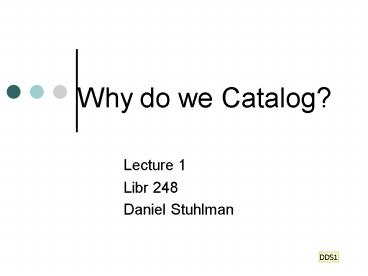Why do we Catalog - PowerPoint PPT Presentation
1 / 16
Title:
Why do we Catalog
Description:
Personal, book store, elementary school classroom, research library. How ... choice of a book ... most valuable collections, beyond buying and copying books. ... – PowerPoint PPT presentation
Number of Views:53
Avg rating:3.0/5.0
Title: Why do we Catalog
1
Why do we Catalog?
- Lecture 1
- Libr 248
- Daniel Stuhlman
2
Collections 1
- Think about your own collections of items.
- How do you arrange them?
- Function
- ? Dishes in the kitchen
- ? Books in the study
- ? Repair tools in the workroom
3
Collections 2
- Size
- ? Larger items on larger shelves
- ? Cars in the garage
- ? Books segregated by size
- Age
- ? Most recent items on top
4
Collections 3
- Kind of item
- ? Spoons, forks, and knives in their own places
in the silverware drawer - ? Books on the book shelves
- ? Fish in the fish tank
- ? Stamps and pictures in albums
5
Order out of chaos 1
- Humans need to make order for objects to be able
to find them when needed - First we name things to be able to recall them.
Second we describe them. For cars we give
vehicle ID numbers and license plate numbers
6
Order out of chaos 2
- For books we have informal rules used by non
librarians or book specialists and formal rules
used by specialist. - Think of following collections
- Personal, book store, elementary school
classroom, research library - How are they arranged?
7
Order out of chaos 3
- Aesthetics
- Ease of access
- Size
- Subject
- Author
- Title
8
Charles Ammi Cutter, 1837-1903.
- From his Rules for a Dictionary Catalog (1876)
- To enable a person to find a book when the one
or more is known - A. the author
- B. the title
- C. the subject
- To show what the library owns
- by author, subject, or a given kind of
literature - To assist in the choice of a book
- as to its edition (bibliographically) as to its
character (literary or topical)
For more information on Charles Cutter
http//web.utk.edu/ebowker/deadgerman.html
9
History of Cataloging 1
- Book catalogs (19th century)
- Card catalogs (20th century)
- Computer databases (now)
10
History of Cataloging 2
- Ancient Library of Alexandia
- The ancient Library was the only truly universal
library. Although no exact count exists, probably
at its peak it held some 700,000 scrolls,
equivalent to about 100-125,000 printed books
today. The Library also encouraged translations.
The Septuagint, the first translation of the
Bible from Hebrew to Greek, took place there. The
Ptolemaic kings paid special attention to enrich
the Library with the treasures of knowledge in
all fields and branches of knowledge. They were
anxious to acquire originals of works and the
most valuable collections, beyond buying and
copying books. They searched each ship that
visited Alexandria and if a book was found, it
would be taken to the Library to be copied and
the copy would be returned to the owner. - The library was burned in 48 BCE and finally
destroyed in the either the 3rd or 4th century.
11
Book Catalogs 1
- Advantages
- Portable
- Low tech
- Does not require special equipment
- Disadvantages
- Takes a long time to create
- Hard to make additions and revisions
- Space is limited
- Costly to create
12
Book Catalogs 2
- Examples of published book catalogs
- National Union Catalog, Pre-1965 Imprints a
cumulative author list representing Library of
Congress printed cards for books, and titles
reported by other North American Libraries.
London Mansell, 1968-1981. - New York Public Libray Dictionary Catalog of the
Slavonic Division. New York G.K. Hall, 1974.
13
Card Catalog
14
Library Management Systems
15
Famous Libraries of the past
The library of Columbia University, New York
Citytaken between 1920 and 1940. From the
Library of Congress collection.
Harvard University Library in 1915. From
Library of Congress collection.
16
Libraries
Carnegie Library from Houston, TX 1900 or later
Central Building of St. Louis, MO Public Library
about 1965. Opened in 1912, one of the finest
examples of Italian Renaissance architecture in
the city.































